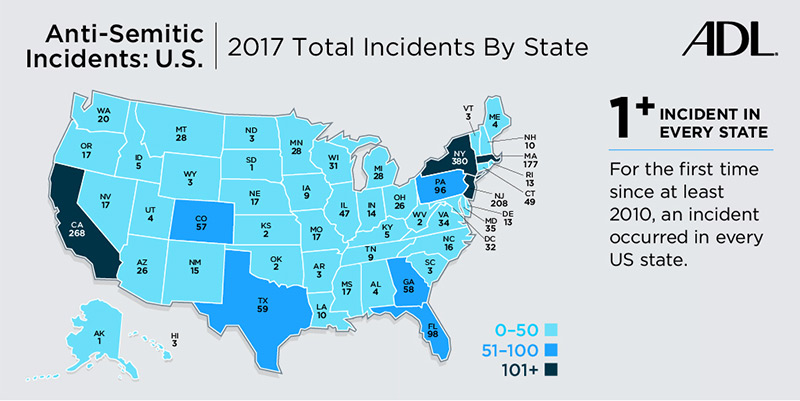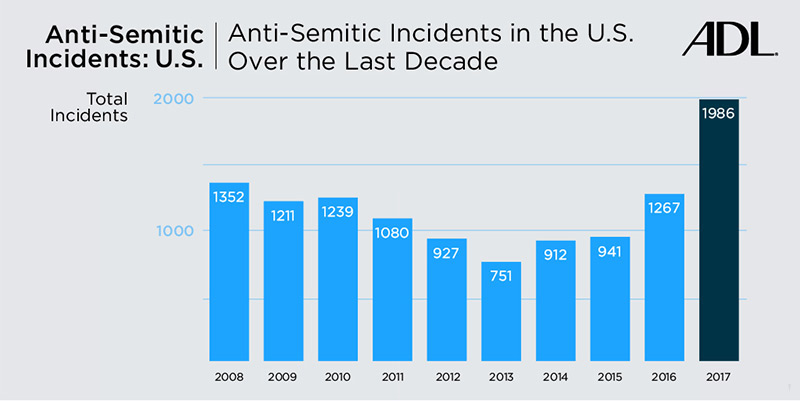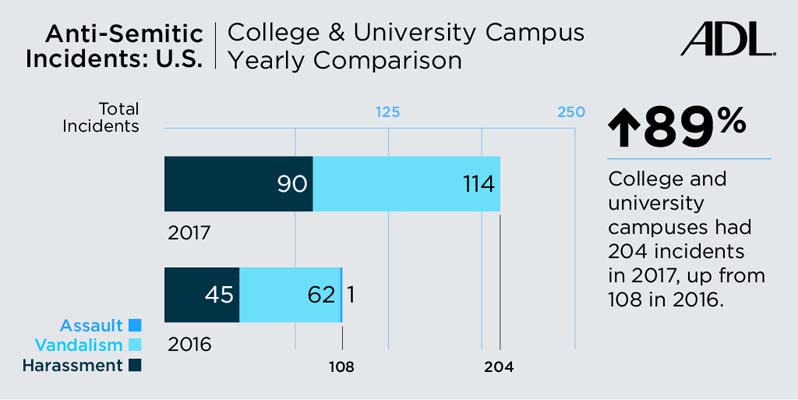Related Content
Introduction
In its annual Audit of Anti-Semitic Incidents, ADL found that the number of anti-Semitic incidents in the U.S. rose 57 percent in 2017 – the largest single-year increase on record and the second highest number reported since ADL started tracking such data in 1979. The sharp rise was in part due to a significant increase in incidents in schools and on college campuses, which nearly doubled for the second year in a row.
Major Findings
ADL identified 1,986 anti-Semitic incidents perpetrated throughout the United States in 2017. This is an increase of 57% over the 1,267 incidents reported in 2016. For the first time since at least 2010, an incident occurred in every US state. The states with the highest numbers of incidents were New York (380 incidents), California (268 incidents), New Jersey (208 incidents), Massachusetts (177), Florida (98), and Pennsylvania (96). These states combined made up more than half (62%)of the total number of incidents. The number of incidents tends to correlate with large Jewish populations.

The 1,986 total incidents can be subdivided into three major categories: (1) of harassment (where a Jewish person or group of people feel harassed by the perceived anti-Semitic words, spoken or written, or actions of someone else); (2)vandalism (where property is damaged in a manner that indicates the presence of anti-Semitic animus or in a manner that victimizes Jews for their religious affiliation), and (3) assault (where people’s bodies are targeted with violence accompanied by expressions of anti-Semitic animus).

The largest increase in 2017 was in the category of vandalism. With 952 incidents recorded, this is an 86% increase over the 510 incidents in 2016. The dramatic increase in anti-Semitic acts of vandalism is particularly concerning, because it indicates that the perpetrators feel emboldened enough to break the law.


In 2017, there were 1,015 instances of harassment, an increase of 41% over the 721 incidents reported in 2016. One hundred sixty-three of the harassment cases were part of the spree of bomb threats made against Jewish institutions in the first quarter of 2017. If those bomb threats were not included in the total number of harassment cases, the total would be 852, an increase of 18% over the 2016 figure.
Thankfully, the number of assaults with perceived anti-Semitic animus decreased to 19 in 2017; a decrease of 47% compared to the 36 assaults in 2016.
Anti-Semitic incidents took place in a wide variety of locations, including places of business, private homes, public areas such as parks and streets, Jewish institutions, schools, and colleges/universities. Although the largest number of incidents typically occur in public areas, in 2017 K-12 schools surpassed public areas as the locations with the most anti-Semitic incidents, at 457 incidents being reported in K-12 schools and 455 in public areas. For public areas, this amounted to an increase of 56% over the 294 incidents in that location type in 2016. For K-12 schools, this is a dramatic increase of 94% over the 235 incidents in 2016. Anti-Semitic incidents on college and university campuses also increased in 2017 to a total of 204, an 89% increase over the 108 incidents in 2016.
Jewish institutions, including Jewish schools, community centers, and museums as well as synagogues, were the targets of 342 anti-Semitic incidents in 2017. This is an increase of 101% over the 170 incidents recorded in 2016. However, this number includes 163 bomb threats made in the first quarter of the year; the vast majority of which were alleged to have been perpetrated by a troubled Jewish teenager located in Israel. Excluding those bomb threats, the total number of incidents targeting Jewish institutions is 179, an increase of 5% over the 170 incidents targeting those places in 2016.
Themes and Trends
Schoolyard Incidents
Anti-Semitic incidents in K-12 schools increased by approximately 100% each year for the past two years. Instances of vandalism with anti-Semitic messages and symbols, as well as harassment and assaults against Jewish children, increased 94% in 2017 over the previous year (from 235 to 457), and increased 106% in 2016 (from 114 to 235). Elementary, middle and high schools have exceeded public spaces (such as parks and streets) as the locations with the most anti-Semitic incidents, surpassing homes, businesses, Jewish institutions, and college campuses. In 2017, 455 incidents were recorded as having taken place in public spaces, and 457 incidents were reported in schools.

Of incidents in K-12 schools, 231 were instances of harassment of Jewish students by their peers. These included one-off expressions of harassment as well as instances of long-term anti-Semitic bullying.

Enhanced reporting and heightened sensitivity to bullying has certainly contributed to the increase in reported incidents, but the nature of schoolyard bullying makes it likely that these reported incidents are actually an underrepresentation of the total amount of anti-Semitic harassment against Jewish students.
Two hundred twenty-one instances of vandalism were reported in K-12 schools. The vast majority of them (186) included swastikas and were either drawn or scratched into school facilities or drawn on Jewish students’ notebooks. This is more than double the 90 vandalism incidents involving swastikas in 2016. In many cases, the swastikas in 2017 were accompanied by phrases like “Hitler was not wrong,” “Heil Hitler,” “Kill all Jews,” and “No Jews.” In a few cases the swastikas were accompanied by the phrase “white power” or neo-Nazi codes, like the numbers 14/88.
Bomb Threats
An Israeli-American teen was arrested in March 2017 and charged with making more than 150 bomb threats to Jewish Community Centers, schools, ADL offices, and other Jewish community institutions. A second man, Juan Thompson, 31, of St. Louis, Missouri, was arrested and charged with making copy-cat threats against Jewish centers and ADL offices. Thompson is alleged to have made at least eight of the threats against JCCs in January and February as part of a sustained campaign to harass and intimidate a former girlfriend. He was charged with one count of cyberstalking, and other charges may be pending.
In total, ADL identified 163 bomb threats against JCCs and other Jewish institutions during the first quarter of 2017. The Justice Department affidavits, which accompanied the announcement of the criminal charges against the Israeli teen, graphically documented the chilling texts of a number of the bomb threats. A number of the calls to Jewish community institutions graphically threatened a “bloodbath” where “Jews” were going to have their heads blown off. Other threats to Jewish institutions included specific language that a large number of “Jew children” were going to have their heads blown off from the shrapnel. And other calls to Jewish institutions included specific threats that the caller was coming to the school to shoot and kill children.
In addition to the 163 bomb threats in the first quarter, an additional six unrelated bomb threats were sent to Jewish institutions in the third and fourth quarters of 2017.
ADL included the bomb threats in the total count because, regardless of the motivation of any specific perpetrator, Jewish communities were repeatedly traumatized by these assaults on their institutions and threats to their safety. The bomb threats sowed fear and anxiety among Jews across the country. These crimes meet the textbook definition of hate crimes: Jewish community institutions were intentionally-selected and targeted — and the bomb threats sparked widespread fear at these institutions, causing evacuations, significant service disruptions, program cancellations, and deep community anxiety.
Cemetery Vandalism:
Jewish graves and/or cemeteries were desecrated seven times in 2017. The desecration of Jewish headstones is a classic form of anti-Semitism employed for hundreds of years by anti-Semites looking to scare, victimize, and offend Jews. It is a cowardly act and especially disturbing, seeing as those buried have no means of defending themselves from such baseless hatred.
- Scottsburg, Indiana – In the Jewish section of the Scottsburg Cemetery “Fuck Jews” was spray-painted on Jewish headstones. (January)
- University City, Missouri – More than 150 headstones at the Chesed Shel Emeth Cemetery were knocked over. (February)
- Philadelphia, Pennsylvania – About 275 tombstones were overturned in the Mt. Carmel Cemetery in the Wissinoming neighborhood. (February)
- Rochester, New York – Headstones at the Vaad Hakolel cemetery were toppled. (March)
- Orange, Connecticut – A one foot-by-one foot swastika was spray-painted onto the wall surrounding Beth Israel Cemetery. (June)
- Hartford, Connecticut – Approximately sixty headstones were vandalized at the Ateres Knesseth Israel cemetery. (July)
- Melrose, Massachusetts – About a half dozen headstones were overturned in the Netherlands Cemetery, a historic Jewish cemetery (July). In August, three teens were found to be responsible and one was charged.
The majority of the cemetery desecrations occurred in the first months of the year, at the same time as the bomb threats discussed above were being called in to Jewish communal institutions. This contributed to a sense among Jews across the country of being under siege. One bright spot in this was the response of members of the Muslim and Christian faiths, who raised thousands of dollars to help repair the damaged tombstones. Vice President Mike Pence’s February visit to the recently-desecrated Chesed Shel Emeth Cemetery in University City, Missouri, was another welcome symbolic gesture.
Another Jewish cemetery in Brooklyn, NY, was also thought to have been vandalized in early March, 2017. However, a police investigation concluded that the fallen headstones at Washington Cemetery were the result of poor upkeep and not vandalism. This incident was not included in the Audit.
Policy Recommendations
In response to the historic rise in anti-Semitic incidents, ADL is sharing the following policy recommendations with members of Congress and other government leaders:
- Congress should pass legislation to expand federal protections against bomb threats to religious institutions. The House of Representatives approved this legislation, HR 1730, in December. The Senate must now act and send the measure to the President to sign.
- Public officials and law enforcement authorities must use their bully pulpit to speak out against anti-Semitic incidents – and all acts of hate. These officials must support efforts to punish this conduct to the fullest extent of the law, while providing comfort and assistance to individual victims and community members.
- Victims and bystanders should report all anti-Semitic incidents and vandalism to the Anti-Defamation League and to local police. If we expect law enforcement officials and community members to take these incidents seriously, we must take them seriously – and report them, both to ADL and to the police.
- College and university administrators, faculty, and staff must receive the necessary training to effectively respond to anti-Semitic incidents, hate crimes, hate speech, and extremism on campus. Campus officials have a moral obligation to speak out against hate. Colleges and universities must build an institution for learning that works toward inclusion and equity while also ensuring open expression and a marketplace for ideas.
Methodology
The Audit of Anti-Semitic Incidents is composed of criminal and non-criminal incidents of harassment, vandalism, and assault against individuals and groups as reported to ADL by victims, law enforcement, and the media. It is not a public opinion poll or an effort to catalog every expression of anti-Semitism on the Internet.
Incidents are defined as vandalism of homes/businesses/public areas, or harassment or assault on individuals or groups, where either 1) circumstances indicate anti-Jewish animus on the part of the perpetrator or 2) the incidents result in Jews perceiving themselves as being victimized due to their Jewish identity. Any vandalism against Jewish religious institutions or cemeteries is also included.
Although some incidents are hate crimes, many incidents included in the Audit include non-criminal acts that rise to the level of an Anti-Semitic Incident as we define above.
All Incidents are assessed by ADL staff for credibility. Wherever possible, ADL staff obtain independent verification of incidents. Where verification is unavailable, incidents may still be included if ADL staff consider the reports to be credible using their best professional judgment.
The Audit excludes the following types of incidents:
- Anti-Semitic activities or statements which take place privately (e.g. a private extremist meeting) or in a manner that requires potential victims to “opt-in” in order to access them (e.g. by going to particular websites where unmoderated discussion occurs, looking at specific individuals’ social media pages, etc.)
- Instances of discrimination (e.g. a Jewish worker not receiving an accommodation for Rosh Hashanah) unless the discrimination is accompanied by verbal harassment as described above
- General expressions of white supremacist or other hateful ideologies, unless those expressions include overt anti-Semitic elements
ADL is careful to not conflate general criticism of Israel or anti-Israel activism with anti-Semitism. However, Israel-related harassment of groups or individuals may be included when the harassment incorporates traditional anti-Jewish references, accusations and conspiracy theories. Also included are cases of picketing of Jewish religious or cultural institutions for purported support for Israel.
Major State Findings
Below you will find links to a selected list of anti-Semitic incidents documented in 2017, as well as a state-by-state breakdown. The graphics that follow represent the states with the highest number of incidents.
Selected List of 2017 Anti-Semitic Incidents
State-by-state Breakdown















